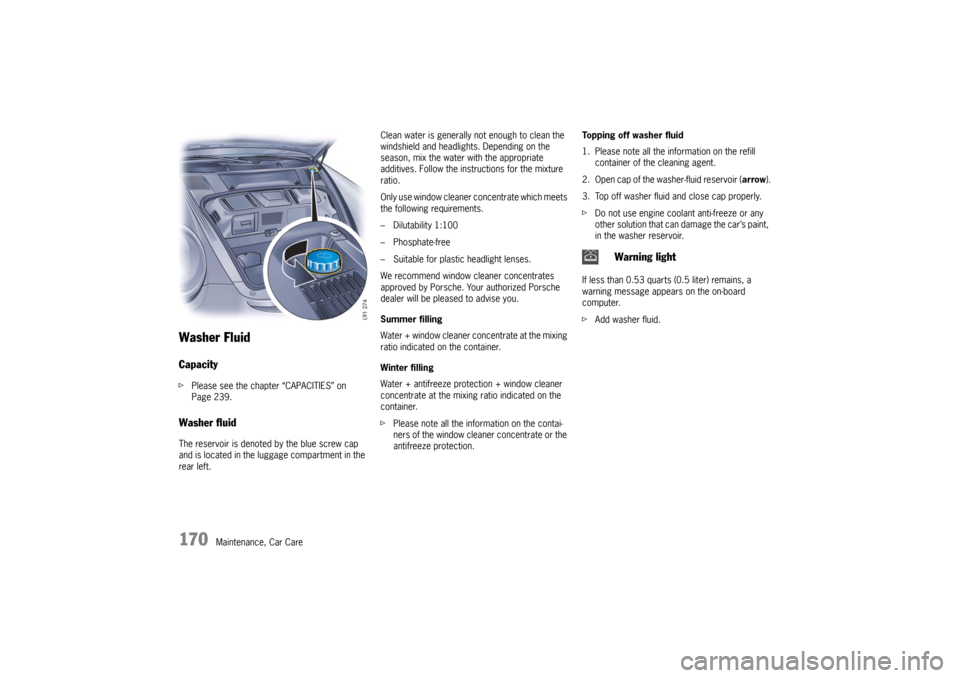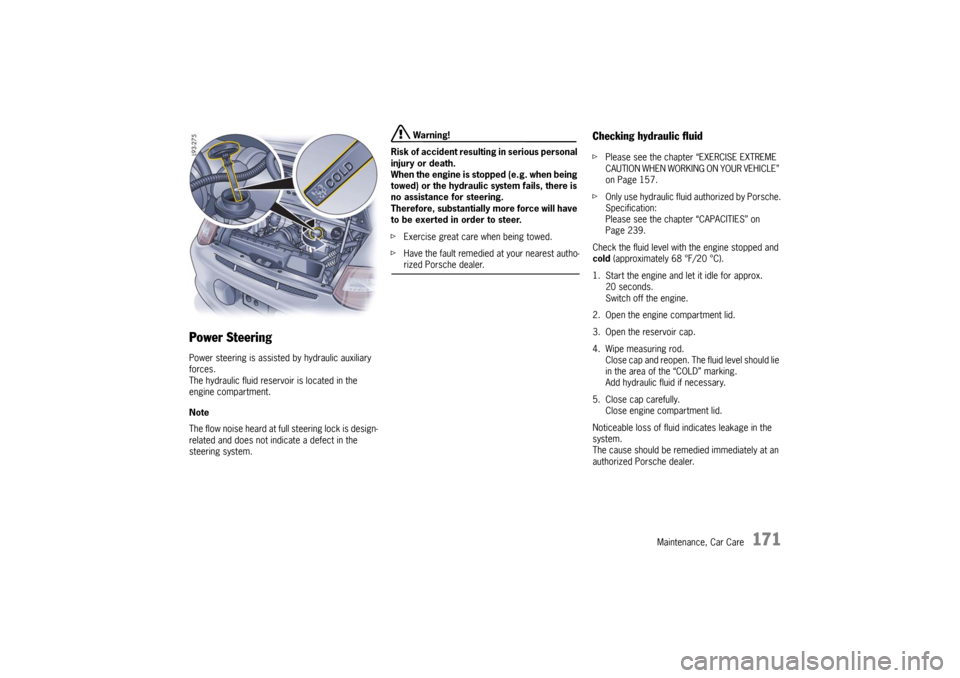PORSCHE 911 GT3 2010 5.G Owners Manual
Manufacturer: PORSCHE, Model Year: 2010, Model line: 911 GT3, Model: PORSCHE 911 GT3 2010 5.GPages: 251, PDF Size: 14.33 MB
Page 171 of 251

170
Maintenance, Car Care
Washer FluidCapacityfPlease see the chapter “CAPACITIES” on
Page 239.Washer fluidThe reservoir is denoted by the blue screw cap
and is located in the luggage compartment in the
rear left.Clean water is generally not enough to clean the
windshield and headlights. Depending on the
season, mix the water with the appropriate
additives. Follow the instructions for the mixture
ratio.
Only use window cleaner concentrate which meets
the following requirements.
– Dilutability 1:100
– Phosphate-free
– Suitable for plastic headlight lenses.
We recommend window cleaner concentrates
approved by Porsche. Your authorized Porsche
dealer will be pleased to advise you.
Summer filling
Water + window cleaner concentrate at the mixing
ratio indicated on the container.
Winter filling
Water + antifreeze protection + window cleaner
concentrate at the mixing ratio indicated on the
container.
fPlease note all the information on the contai-
ners of the window cleaner concentrate or the
antifreeze protection.Topping off washer fluid
1. Please note all the information on the refill
container of the cleaning agent.
2. Open cap of the washer-fluid reservoir (arrow).
3. Top off washer fluid and close cap properly.
fDo not use engine coolant anti-freeze or any
other solution that can damage the car’s paint,
in the washer reservoir.
If less than 0.53 quarts (0.5 liter) remains, a
warning message appears on the on-board
computer.
fAdd washer fluid.
Warning light
10_GT3_21.book Seite 170 Donnerstag, 4. Juni 2009 12:48 12
Page 172 of 251

Maintenance, Car Care
171
Power Steering Power steering is assisted by hydraulic auxiliary
forces.
The hydraulic fluid reservoir is located in the
engine compartment.
Note
The flow noise heard at full steering lock is design-
related and does not indicate a defect in the
steering system.
Warning!
Risk of accident resulting in serious personal
injury or death.
When the engine is stopped (e.g. when being
towed) or the hydraulic system fails, there is
no assistance for steering.
Therefore, substantially more force will have
to be exerted in order to steer.
fExercise great care when being towed.
fHave the fault remedied at your nearest autho-rized Porsche dealer.
Checking hydraulic fluid fPlease see the chapter “EXERCISE EXTREME
CAUTION WHEN WORKING ON YOUR VEHICLE”
on Page 157.
fOnly use hydraulic fluid authorized by Porsche.
Specification:
Please see the chapter “CAPACITIES” on
Page 239.
Check the fluid level with the engine stopped and
cold (approximately 68 °F/20 °C).
1. Start the engine and let it idle for approx.
20 seconds.
Switch off the engine.
2. Open the engine compartment lid.
3. Open the reservoir cap.
4. Wipe measuring rod.
Close cap and reopen. The fluid level should lie
in the area of the “COLD” marking.
Add hydraulic fluid if necessary.
5. Close cap carefully.
Close engine compartment lid.
Noticeable loss of fluid indicates leakage in the
system.
The cause should be remedied immediately at an
authorized Porsche dealer.
10_GT3_21.book Seite 171 Donnerstag, 4. Juni 2009 12:48 12
Page 173 of 251

172
Maintenance, Car Care
Air Filter A dirty air filter not only reduces engine perfor-
mance, but can lead to premature engine wear.
Regular filter replacement is part of the routine
maintenance service.
fIn dusty conditions, check the filter element
more frequently and replace if necessary.Combination Filter The fresh air passing through the combination
filter into the passenger compartment is virtually
free of dust, pollen, and unpleasant odors.
fIf the outside air is polluted by exhaust fumes,
press the recirculating-air button.
A dirty filter can be the cause of reduced air flow:
fHave filter replaced by your authorized
Porsche dealer.
Regular filter replacement is part of the routine
maintenance service.
Manual Transmission OilThe transmission oil has to be checked and
changed at the intervals listed in your Maintenance
Schedule.
fPlease see the chapter “CAPACITIES” on
Page 239.
We recommend that you have the transmission oil
changed at your authorized Porsche dealer, who
has the required lubricants and the necessary
filling equipment.
fIf you suspect an oil leak in the transmission,
have your authorized Porsche dealer check it
out immediately.
10_GT3_21.book Seite 172 Donnerstag, 4. Juni 2009 12:48 12
Page 174 of 251

Maintenance, Car Care
173
Wiper Blades Wiper blades that are in perfect condition are vital
for a clear view.
fReplace the wiper blades twice per year
(before and after the cold season) or whenever
wiper performance deteriorates.
Caution!
Risk of damage if the wiper arm accidentally
falls back on to the window.
fAlways hold the wiper arm securely when repla-
cing the wiper blade.
Risk of damage if wiper blades that are
frozen in place are loosened improperly.
fThaw the wiper blades before loosening them.
Maintenance note
fPeriodically clean the wiper blades with
window cleaner, especially after the vehicle
has been washed in a car wash.
We recommend the Porsche window cleaner. If
they are very dirty (e.g. with insect remains),
the windows can be cleaned with a sponge or
cloth.If the wiper blades rub or squeak, this can be as a
result of the following:
– If the vehicle is washed in an automatic car
wash, wax residues may adhere to the winds-
hield. These wax residues can be removed
only by using window cleaner concentrate.
– The wiper blades may be damaged or worn.
fReplace damaged or worn wiper blades as
soon as possible.
fPlease see the chapter “WASHER FLUID” on
Page 170.
fPlease contact your authorized Porsche dealer
for further information.
Changing windshield wiper bladesfPlease follow the separate instructions for
fitting wiper blades as supplied by the
manufacturer.
fWe recommend that you get your authorized
Porsche dealer to replace the wiper blades.
Caution!
Risk of damage.
If a wiper blade is not changed properly, it
can come loose when the car is moving.
fCheck whether the wiper blade is seated
securely.
The wiper blade must engage the wiper arm properly.
10_GT3_21.book Seite 173 Donnerstag, 4. Juni 2009 12:48 12
Page 175 of 251

174
Maintenance, Car Care
Car Care Instructions fPlease see the chapter “EXERCISE EXTREME
CAUTION WHEN WORKING ON YOUR VEHICLE”
on Page 157.
Regular and correct care helps to maintain
the value of your car and is also a precondi-
tion for the New Vehicle Warranty and the
Anti Corrosion Warranty.
Your authorized Porsche dealer has specially
developed car-care products from the
Porsche program available either singly or
as complete car-care sets. They will be
pleased to help you select suitable products.
Whether you use Porsche products or other
commercially available cleaning agents first
make sure of their correct application.
A Porsche that is well-cared for can look like new
for years. It all depends on the amount of care the
owner is willing to give the car.
Warning!
Risk of serious personal injury or damage to
the vehicle or property.
Cleaning agents may be hazardous to your
health.
Most chemical cleaners are concentrates
which require dilution. High concentrations
might cause problems ranging from irritation
to serious injury as well as damage to your
vehicle.
fKeep cleaning agents out of reach from
children.
fObserve all caution labels.
fAlways read directions on the container before
using any product. These directions may
contain information necessary to avoid
personal injury.
fDo not use fuel, kerosene, naphtha, nail polish
remover or other volatile cleaning fluids. They
may be toxic, flammable or hazardous in other
ways. Only use spot removing fluids in a well
vented area.
fDo not clean the underside of chassis,
fenders, wheel covers, etc., without protecting
your hands and arms as you may cut yourself on sharp-edged metal parts.
Moisture and road salt on brakes may affect
braking efficiency.
fTest the brakes after each vehicle washing.
High-pressure cleaning equipment, steam
cleaners
Warning!
High-pressure cleaning equipment or steam
cleaners can damage the following compon-
ents:
–tires,
– logos, emblems,
– painted surfaces,
– alternator.
fPlease observe the operating instructions from
the unit manufacturer.
fWhen cleaning with a flat-jet nozzle or the like,
maintain a minimum distance of 20 inches
(50 cm).
fNever use high-pressure cleaning equipment
or steam cleaners with a round-jet nozzle. A
high-pressure cleaning equipment or steam
cleaners with round nozzle will damage your
vehicle.
fThe tires are particularly susceptible to
damage.
fDo not point the cleaning jet directly at any of the aforementioned components.
10_GT3_21.book Seite 174 Donnerstag, 4. Juni 2009 12:48 12
Page 176 of 251

Maintenance, Car Care
175
Decals
Caution!
Risk of damage due to separation of the
decal films when using high-pressure
cleaning equipment or steam cleaners.
fDo not use high-pressure cleaning equipment or steam cleaners to clean decal films.
Washing The best method of protecting your car from the
damaging effects of the environment is frequent
washing and the application of a preservative. The
underside of your vehicle should also be
thoroughly washed for cinders, salt or sanding at
winter’s end.
The longer salt, road dust and industrial dust,
dead insects, bird droppings or substances from
trees (resin, pollen) are allowed to remain on the
bodywork, the more serious is their harmful
effect.
New cars should be washed carefully with plenty
of clear water to protect the new paint work. Dark
paint finishes show up the smallest of surface
damage (e.g., scratches) more readily than lighter
colors. Dark colors are also more susceptible to
scratching because of the composition of their
pigments and require particularly careful paint
care.
fDo not wash your car in bright sunlight or while
the bodywork is still hot.
fWhen washing by hand, use abundant water, a
soft sponge or wash brush, and Porsche car
shampoo.
fBegin by spraying the body thoroughly with
water to rinse away loose dirt.
fAfter washing, rinse the car with plenty of
water and then dry with a chamois leather.
Do not use the same chamois leather for
drying as you use for cleaning the windshield
and windows.
Warning!
Moisture which gets on to the brakes during
a car wash can reduce braking efficiency or
make the brakes pull unevenly which could
increase the danger of an accident, causing
serious personal injuries or death.
fAfter washing the car, test the brakes and
steering and briefly brake the discs dry.
When doing this, take care not to hamper other
road users behind you (traffic conditions permitting). Automatic car washes
fPlease see the chapter “WIPER BLADES” on
Page 173.
Optional add-on parts or parts which project
beyond the contours of the vehicle may be
damaged by design features (e.g. brushes) of
automatic car washes.
The following parts are particularly
susceptible to damage:
– Windshield wipers (always switch them off to
prevent them wiping unintentionally in intermit-
tent or sensor operation)
– External antennas (always unscrew)
– Rear spoiler
– Wheels (the wider the rim and the lower the tire
height, the greater the risk of damage)
– High-gloss wheels (to prevent these from
getting scratched, do not clean with the wheel-
cleaning brushes of the car wash).
fPlease consult the operator before using
automatic car washes.
fWash and dry by hand all points not reached by
a car wash, such as door and lid seams or
door sills.
10_GT3_21.book Seite 175 Donnerstag, 4. Juni 2009 12:48 12
Page 177 of 251

176
Maintenance, Car Care Note
Automatic car washes spray water at odd angles
and high pressures, which are not seen in normal
driving. Therefore, water can sometimes find its
way into the passengers compartment during or
shortly after the car wash.
Door lock fTo prevent the door lock from freezing during
the cold season, the lock cylinder should be
covered during a wash.
fShould the lock freeze, use an ordinary de-icer.
In many cases, a well warmed key can help.
Never use excessive force.Paint fNever rub a dusty car with a dry cloth since
dust particles are abrasive and could dull and
damage the surface finish.
The paintwork of your car is exposed to all types
of mechanical and chemical conditions, particu-
larly climatic ones such as bright sunlight, rain,
frost and snow. Ultraviolet light, rapid changes in
temperature, rain, snow, industrial dust and
chemical deposits constantly attack the paint
which is only able to withstand such exposure in
the long term if it is given regular care and atten-
tion.
fDo not apply silicone polishes to the windshield
or windows. fDo not treat matt-painted components with
preservatives or polishes as this will spoil the
matte effect.
Preservation
The paint surface becomes dull over time due to
weathering. It is therefore necessary to preserve
the paint regularly.
This keeps the paint shiny and elastic. Dirt is
prevented from adhering to the paint surface and
industrial dust is prevented from penetrating the
paint.
Provided it is washed and treated with preserva-
tive regularly, the brand new finish of your car will
be retained for years to come.
fApply paint preservative after the car wash and
polish it dry to obtain a bright finish.
Polishing
Do not resort to using Porsche polish until it
becomes evident that the normal preservatives no
longer produce the desired finish.
Spots and stains
fRemove tar stains, grease, oil spots and dead
insects as soon as possible with Insect
Remover. They can cause discoloration if
allowed to remain on the paintwork.
fWash the affected area immediately after
treating it.Minor paint damage
fHave minor paint damage, such as scratches,
scores or chips caused by flying stones,
repaired immediately by your authorized
Porsche dealer before corrosion sets in.
However, if there are already traces of corrosion,
they must first be removed carefully and
thoroughly. Coat the area with a rust-proofing
primer and finish off with a top coat. The paint
code and color number are found on the data bank
in the Maintenance booklet. 10_GT3_21.book Seite 176 Donnerstag, 4. Juni 2009 12:48 12
Page 178 of 251

Maintenance, Car Care
177
Engine compartment The engine compartment and the surface of the
engine are treated with a corrosion-inhibitor at the
factory.
If degreasing solvents are used to clean the
engine compartment or the engine is washed
down, the process almost invariably removes the
corrosion-inhibiting coating. It is then absolutely
necessary to have a durable preservative applied
to all surfaces, body seams, joints and assemblies
in the engine compartment. This also applies
when corrosion-inhibitor parts are replaced.
Caution!
Risk of damage to the alternator.
fDo not point the cleaning jet directly at the alternator, or cover the alternator.
Effective corrosion-proofing is particularly impor-
tant during the cold weather season. If your car is
driven frequently in areas where salt has been
spread on the roads, the whole engine compart-
ment should be cleaned thoroughly after the
winter to prevent salt from causing any lasting
damage. A full under-body wash should also be
performed at the same time.
Windows The road dust which settles on the windshield and
windows contains particles of tire rubber and oil
residue. The interior trim and upholstery release
particles, particularly in strong sunlight, which
collect on the insides of the windows. These
deposits are augmented by impurities in the air
which enters the car through the fresh air vents.
fClean all windows regularly, inside and outside,
with Porsche window cleaner.
fIf you use a chamois leather for the windows,
do not use it for paintwork as it will otherwise
pick up a certain amount of preservative or
polish and could smear the windows and thus
impair vision.
fRemove dead insects with Porsche insect
remover.
Note
Door windows feature a water-repellent (hydro-
phobic) coating which prevents soiling of the
windows.
This coating is subject to natural wear and can be
renewed.
fConsult an authorized Porsche dealer.
Wiper blades Wiper blades that are in perfect condition are vital
for a clear view.
fReplace the wiper blades twice per year
(before and after the cold season) or whenever
wiper performance deteriorates.
fPeriodically clean the wiper blades with
Porsche window cleaner, especially after the
vehicle has been washed in a car wash.
If they are very dirty (e.g. with insect remains),
they can be cleaned with a sponge or cloth.
If the wiper blades rub or squeak, this can be as a
result of the following:
– If the vehicle is washed in an automatic car
wash, residues may adhere to the windshield.
These wax residues can be removed only by
using window cleaner concentrate.
– The wiper blades may be damaged or worn.
fReplace damaged wiper blades as soon as
possible.
Please see the chapter “WIPER BLADES” on
Page 173.
fPlease see the chapter “WASHER FLUID” on
Page 170.
fPlease contact your authorized Porsche dealer
for further information.
10_GT3_21.book Seite 177 Donnerstag, 4. Juni 2009 12:48 12
Page 179 of 251

178
Maintenance, Car Care
Undercoating As it is not possible to exclude the risk of damage
to this protective coating in day to day driving, it
is advisable to have the underside of the car
inspected at certain intervals – preferably before
the start of winter and again in spring – and the
undercoating restored as necessary.
Your authorized Porsche dealer is familiar with the
bodyseal treatment procedures and has the
necessary equipment for applying factory
approved materials. We recommend that you
entrust them with such work and inspections.
Unlike conventional spray oils, undercoating and
rust-proofing compounds based on bitumen or
wax do not attack the sound-proofing materials
applied at the factory.
Warning!
Danger of fire resulting in serious personal
injury or death.
fDo not apply additional undercoating or rust-
proofing on or near the exhaust manifold,
exhaust pipes, catalytic converters or heat
shields. During driving the substance used for undercoating could overheat and ignite.
fBefore applying fresh underseal, carefully
remove any deposits of dirt and grease. Once
it has dried, the new undercoating compound
forms a tough protective coating which
provides efficient rust-proofing of the floor
panels and components. fAlways apply a fresh coating of suitable preser-
vative to unprotected areas after cleaning the
underside of the body, the transmission, the
engine or carrying out repairs to under-body,
engine or transmission components.
Effective rust-proofing is particularly important
during the cold weather season. If your car is
driven frequently in areas where salt has been
spread on the roads, the whole engine compart-
ment should be cleaned thoroughly after the
winter to prevent salt from causing any lasting
damage. A full under-body wash should also be
performed at the same time.
Stainless steel exhaust tailpipesStainless steel exhaust tailpipes can discolor due
to soiling, strong heat, and combustion residues.
The original polish can be achieved again using
commercially available metal polishing paste or
metal polish.
Light alloy wheels fPlease see the chapter “WASHING” on
Page 175.
Warning!
Danger of accident resulting in serious
personal injury or death if cleaning agents
(e.g. wheel cleaning agents) come into
contact with the brake discs.
The resulting film on the brake discs can
impair braking performance.
fMake sure that no cleaning agent comes into
contact with the brake discs.
fIf cleaning agent has come into contact with
the brake discs, thoroughly clean the brake
discs with a strong jet of water.
fPaying attention to any road users behind you,
dry the brake discs by applying the brakes at short intervals.
Pitting may occur if metallic particles which cause
contact corrosion (e.g. brass or copper in brake
dust) are allowed to remain on the aluminum for
too long.
fIf possible, wash the wheels with a sponge or
wash brush about every two weeks. In areas
where salt is spread on winter roads or there is
a lot of airborne industrial dust, it is best to
clean the wheels weekly.
10_GT3_21.book Seite 178 Donnerstag, 4. Juni 2009 12:48 12
Page 180 of 251

Maintenance, Car Care
179
The Porsche Light Alloy Wheel Cleaner
(ph-value 9.5) can be used for this
purpose.
If the ph-value of the detergent is incor-
rect, the protective coating on the wheels
will be destroyed.
Polishes which dissolve oxides, such as those
frequently used for other metals, or abrasive
tools or agents are unsuitable because they
break down the oxide film of the protective
coating and will cause discoloration of the
wheel.
fEvery three months, after cleaning, coat the
wheels with a car wax or non-corrosive grease
(vaseline).
Using a clean cloth thoroughly rub the grease
into the surface.
Door, roof, lid and window seals fWash dirt (e.g. abrasion, dust, road salts) from
all seals regularly using warm soapy water. Do
not use any chemical cleaning agents or
solvents.
When there is a frost hazard, the outer door seals
and the front and rear lid seals can be protected
against freezing into place by a suitable care
product.
In order to prevent damage to the anti-
friction coating, the inner door seals must
not be treated with care products.
Headlights, lights, interior and exterior
plastic parts, adhesive filmsfUse only clean water and a little dishwashing
detergent to clean light lenses, plastic
headlight lenses, plastic parts and surfaces.
Do not clean when dry.
Use a soft sponge or a soft, lint-free cloth.
Gently wipe the surface without applying too
much pressure.
The Porsche inside window cleaner is also
suitable for cleaning plastic surfaces.
Follow the cleaning instructions on the
container.
Never use other chemical cleaners or
solvents.
fRinse cleaned surfaces with clear water.Leather Characteristics and special features
The natural surface markings of leather, e.g.
creases, healed scars, insect sting marks, struc-
tural differences and slight variations in shade and
grain add to the attractiveness of the natural
leather product.
A special mention must be made here of natural
leather.
For natural leather, carefully selected hides of the
highest quality are used. It is not covered comple-
tely with dye on production.
“Nature’s signature” is therefore easily recogniz-
able.This fine material is distinguished by an outstan-
ding seating comfort, special suppleness and a
typical patina.
Leather care and treatment
fClean all types of leather regularly to remove
fine dust using a soft, damp, white woollen
cloth or a commercially available microfiber
cloth.
fRemove heavy contamination with Porsche
leather cleaner.
Please always follow the instructions for use
given on the containers.
Caustic cleaners and hard cleaning objects
must not be used.
Perforated leather must under no circum-
stances get wet on its reverse side.
Once cleaned, leather (particularly the heavily
stressed leather seats) must be treated only with
Porsche leather care liquid.
10_GT3_21.book Seite 179 Donnerstag, 4. Juni 2009 12:48 12